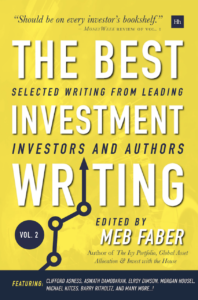The best writing on investing from the smartest people
Meb Faber's 41 hand-selected articles gives you a Master's course in investing
Advertisement
Meb Faber's 41 hand-selected articles gives you a Master's course in investing
 SPEEDREADER
Book: The Best Investment Writing: Selected writings from leading investors and authors (Vol. 2)
Author: Meb Faber
Publisher: Harriman House Ltd.
Where to buy: Amazon
Price: Hardcover $23.46, Kindle $15.11
Who it’s for: Investors interested in reading “the best writing from the smartest people” who are basically smart folks who managed billions of dollars of money for other investors.
More specifically: Those interested in improving their own portfolio and investing results as well as those curious about financial planning.
Key investment insight: The trick to good investing is not longer about obtaining information but to select what is relevant and tune out everything else.
Why we like it: It’s a thought-provoking compilation of 41 short essays and writings that open a reader’s eyes to the many facets of investment research and stock price projection techniques. From writings on market conditions, risk and return, investment portfolio strategies, pricing and valuation, behavioural bias and beyond, there’s lots to learn on several topics.
SPEEDREADER
Book: The Best Investment Writing: Selected writings from leading investors and authors (Vol. 2)
Author: Meb Faber
Publisher: Harriman House Ltd.
Where to buy: Amazon
Price: Hardcover $23.46, Kindle $15.11
Who it’s for: Investors interested in reading “the best writing from the smartest people” who are basically smart folks who managed billions of dollars of money for other investors.
More specifically: Those interested in improving their own portfolio and investing results as well as those curious about financial planning.
Key investment insight: The trick to good investing is not longer about obtaining information but to select what is relevant and tune out everything else.
Why we like it: It’s a thought-provoking compilation of 41 short essays and writings that open a reader’s eyes to the many facets of investment research and stock price projection techniques. From writings on market conditions, risk and return, investment portfolio strategies, pricing and valuation, behavioural bias and beyond, there’s lots to learn on several topics.
READ: Book review: Investing = rational thinking + emotionFavorite essays: “Waiting for the Market to Crash is a Terrible Strategy,” by Samuel Lee, “Skis and Bikes: The Untold Story of Diversification,” by Adam Butler, Michael Philbrick and Rodrigo Corillo, as well as “Portfolios in Wonderland & The Weird Portfolio’ by Corey Hoffstein. Best read: Samuel Lee’s “Waiting for the Market to Crash is a Terrible Strategy.” In a nutshell, Lee shows how putting cash to work in the market only after a crash has been a terrible strategy, far worse than buying and holding. Lee provides six different scenarios of the “buy and after a crash” theory and shows in all cases how they strategy has failed. “As strange as it sounds, you would have been better off buying when the market was going up and selling when it was going down, using a trend-following rule.” Some valuable insights into: The four pillars of retirement income, the truth about cryptocurrencies and why $1 trillion will flow into Chinese stock markets. Final tip: If you liked this volume, consider buying Vol. 1 of the series, available on Amazon.
Share this article Share on Facebook Share on Twitter Share on Linkedin Share on Reddit Share on Email